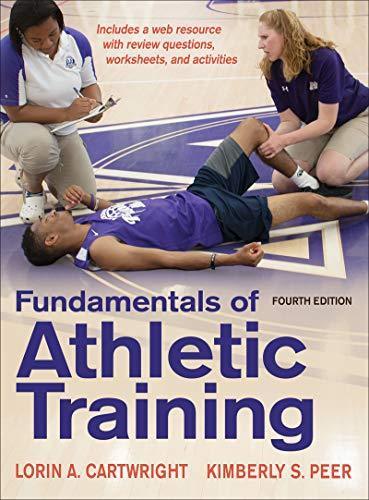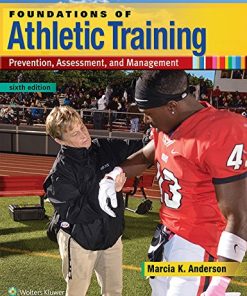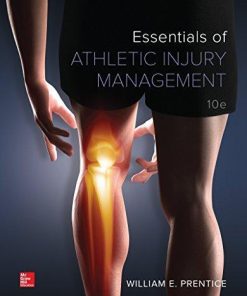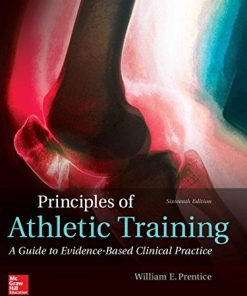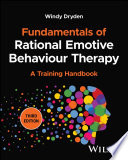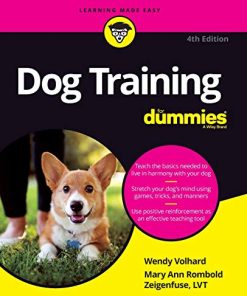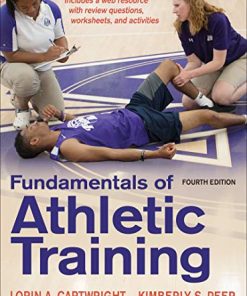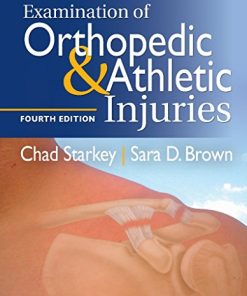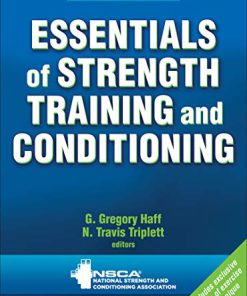Fundamentals of Athletic Training 4th Edition
$50.00 Original price was: $50.00.$25.00Current price is: $25.00.
Fundamentals of Athletic Training 4th Edition – Digital Instant Dowload.
Fundamentals of Athletic Training 4th Edition – Digital Instant Dowload.
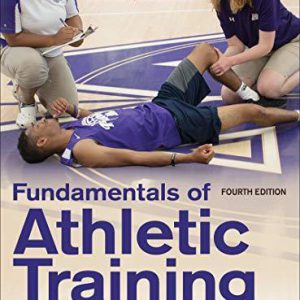
Product details:
- ISBN-10 : 1492561495
- ISBN-13 : 978-1492561491
- Author: Lorin A. Cartwright (Author), Kimberly Peer (Author)
Written specifically for college students Fundamentals of Athletic Training, 4th Edition provides the foundational knowledge and skills needed to assist athletic trainers on and off the field. This introductory text features head-to-toe coverage of common injuries with explanations of the different protocols. The text discusses various conditions, illnesses and communicable diseases along with information on nutrition and the effects of therapeutic, recreational and performance-enhancing drug use. Fundamentals of Athletic Training, 4th Edition is the ideal guide for students considering their career options, acting as a springboard to a future in athletic training and sports medicine.
Table contents:
Unit I: Professional and Administrative Aspects of Athletic Training
1. Athletic Training as a Profession
Roles of the Athletic Trainer
The Sports Medicine Team
Becoming a Certified Athletic Trainer
Athletic Training Careers
National Athletic Trainers’ Association
2. Administration and Professional Development
Legal Issues
Avoiding Legal Problems
Insurance
Professional Development and Continuing Education
The PREMIER Model
3. Design and Development of the Athletic Training Facility
Facility Design and Development
Safety Factors and Planning Issues
Maintenance of Facility and Modalities
Material Safety Data Sheets
Facility Rules
4. Documentation and Record Keeping
Medical Terminology Basics
Medical Documentation Notes
Documentation and Record Keeping
Patient Confidentiality
5. Fiscal Management
Types of Budgets
Designing a Budget
Purchasing
Inventory Management
6. The Preparticipation Physical Exam
Preparticipation Format and Parts
Medical Information Forms
Clearance for Participation in Sport
Unit II: Basics of Human Anatomy and Physiology
7. Introduction to Anatomy
Anatomical Position
Body Tissues
Classification of Joints
Muscle Movement
8. Basics of Tissue Injuries
Soft-Tissue Injuries
Bone Injuries
Unit III: Athletic-Related Injuries to the Head, Spine, and Axial Region
9. Head Injuries
Anatomy of the Head
Preventing Head Injuries
Head Injury Mechanisms
Treating Head Injuries
10. Facial Injuries
Anatomy of the Facial Region
Preventing Facial Injuries
Treating Eye Injuries and Conditions
Treating Ear Injuries
Treating Nose Injuries
Treating Mouth Injuries
11. Throat and Thorax Injuries
Anatomy of the Throat
Anatomy of the Thorax
Preventing Throat and Thorax Injuries
Treating Throat Injuries and Conditions
Treating Thorax Injuries and Conditions
12. Abdominal Injuries
Anatomy of the Abdomen
Preventing Abdominal Injuries
Treating Abdominal Injuries and Conditions
13. Spinal Injuries
Anatomy of the Spine
Postural Considerations
Preventing Spinal Injuries
Treating Lumbar Spine Injuries and Conditions
Treating Cervical Spine Injuries and Conditions
Unit IV: Athletic-Related Injuries to the Upper Extremity
14. Shoulder Injuries
Anatomy of the Shoulder
Preventing Shoulder Injuries
Treating Shoulder Injuries
Muscle, Bursa, and Tendon Injuries
Ligament and Joint Injuries
15. Elbow Injuries
Anatomy of the Elbow
Preventing Elbow Injuries
Treating Elbow Injuries and Conditions
16. Wrist and Hand Injuries
Anatomy of the Wrist and Hand
Preventing Wrist and Hand Injuries
Treating Wrist and Hand Injuries and Conditions
Unit V: Athletic-Related Injuries to the Lower Extremity
17. Hip, Pelvis, and Thigh Injuries
Anatomy of the Hip, Pelvis, and Thigh
Preventing Hip, Pelvis, and Thigh Injuries
Treating Hip, Pelvis, and Thigh Injuries and Conditions
18. Knee Injuries
Anatomy of the Knee
Preventing Knee Injuries
Treating Knee Injuries and Conditions
19. Foot, Ankle, and Lower-Leg Injuries
Anatomy of the Foot, Ankle, and Lower Leg
Preventing Foot, Ankle, and Lower-Leg Injuries
Treating Foot, Ankle, and Lower-Leg Injuries and Conditions
Unit VI: Rehabilitation and Reconditioning of Athletic Injuries
20. Patient Assessment and Treatment Methods
Assessing the Athlete and Documenting the Findings
Phases of Treatment
Therapeutic Modalities
21. Reconditioning Programs
Strength and Conditioning Principles
Types of Muscle Actions
Muscular Development Programs
Joint Flexibility
Exercises for Reconditioning Muscles
Cardiorespiratory Conditioning
A Word on Safety
22. Psychosocial Aspects of Athletic Training
Referring an Athlete for Professional Help
Relationship Building
Practical Suggestions
Unit VII: Providing Emergency Care
23. Planning for Emergencies
Medical Emergency Cards
The Crisis Plan
Practicing the Crisis Plan
24. Primary and Secondary Procedures
Primary Assessment
Breathing Emergencies
Cardiopulmonary Emergencies
Hemorrhage
Preventing Communicable Disease Transmission
Secondary Assessment
HIT
Specific Conditions
PRICES Method
25. Environmental Situations and Injuries
Heat-Related Problems
Cold-Related Problems
Severe Weather
Bites and Stings
26. Stabilization and Transportation of Injured Athletes
Equipment Removal
Lifting and Moving an Athlete
Unit VIII: Preventing Athletic Injuries
27. Protective Taping and Wrapping
Principles of Taping
Taping Techniques
Elastic Wrapping Techniques
28. Protective Equipment Used in Athletics
Protective Equipment for the Head and Face
Protective Equipment for the Upper Body
Protective Equipment for the Lower Body
Unit IX: Other Athletic Conditions and Concerns
29. Basic Diagnostic Imaging and Testing
X-Rays
Bone Scans
CT Scans
MRI
Ultrasound
DEXA Scans
PET Scans
Blood Testing
Drug Testing
30. Conditions and Illnesses
Respiratory Conditions
Vascular Conditions
Gastrointestinal Conditions
Diabetes
Epilepsy
Arthritis
Female Athlete Triad
Rhabdomyolysis
31. Communicable Diseases
Defending Against Microorganisms
Blood-Borne Conditions
32. Common Drugs Used in Athletics
Therapeutic Drugs
Recreational Drugs
Performance-Enhancing Drugs
Over-the-Counter (OTC) Drugs
Drug Abuse
Safety in Distribution of Medications
Proper Disposal of Medications
33. Nutrition and Weight Control
Major Nutrients
Healthy Diet
Understanding Food Nutrition Labels
Caloric Balance
Sport Nutrition
Popular Nutritional Supplements
34. Athletes With Disabilities or Disorders
History of Disabled Sport
Orthopedic Disabilities
Auditory and Visual Impairments
Cardiovascular Disorders
Transplants
Neuromuscular Disorders
Assessing Participation Conditions
Common Injuries
You may also like…
Uncategorized
Foundations of Athletic Training: Prevention, Assessment, and Management 6th Edition, (Ebook PDF)
Uncategorized
Uncategorized
Psychology - Psychotherapy
Animals & Pets - Dogs
Dog Training For 4th Edition by Wendy Volhard, Mary Ann Rombold-Zeigenfuse 1119656877 9781119656876


